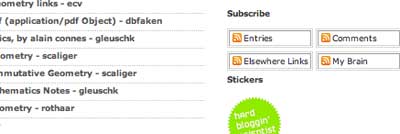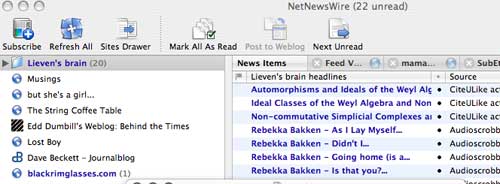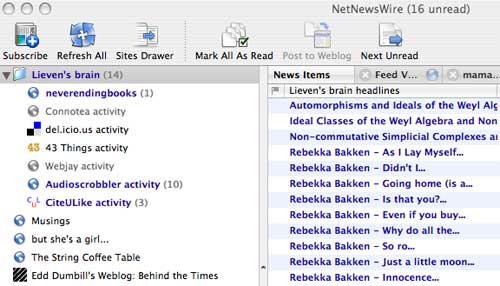Here’s
an appeal to the few people working in Cuntz-Quillen-Kontsevich-whoever
noncommutative geometry (the one where smooth affine varieties
correspond to quasi-free or formally smooth algebras) : let’s rename our
topic and call it non-geometry. I didn’t come up with
this term, I heard in from Maxim Kontsevich in a talk he gave a couple
of years ago in Antwerp. There are some good reasons for this name
change.
The term _non-commutative geometry_ is already taken by
much more popular subjects such as _Connes-style noncommutative
differential geometry_ and _Artin-style noncommutative algebraic
geometry_. Renaming our topic we no longer have to include footnotes
(such as the one in the recent Kontsevich-Soibelman
paper) :
We use “formal” non-commutative geometry
in tensor categories, which is different from the non-commutative
geometry in the sense of Alain Connes.
or to make a
distinction between _noncommutative geometry in the small_ (which is
Artin-style) and _noncommutative geometry in the large_ (which in
non-geometry) as in the Ginzburg notes.
Besides, the stress in _non-commutative geometry_ (both in Connes-
and Artin-style) in on _commutative_. Connes-style might also be called
‘K-theory of $C^*$-algebras’ and they use the topological
information of K-theoretic terms in the commutative case as guidance to
speak about geometrical terms in the nocommutative case. Similarly,
Artin-style might be called ‘graded homological algebra’ and they
use Serre’s homological interpretation of commutative geometry to define
similar concepts for noncommutative algebras. Hence, non-commutative
geometry is that sort of non-geometry which is almost
commutative…
But the main point of naming our subject
non-geometry is to remind us not to rely too heavily on our
(commutative) geometric intuition. For example, we would expect a
manifold to have a fixed dimension. One way to define the dimension is
as the trancendence degree of the functionfield. However, from the work
of Paul Cohn (I learned about it through Aidan Schofield) we know that
quasi-free algebras usually do’nt have a specific function ring of
fractions, rather they have infinitely many good candidates for it and
these candidates may look pretty unrelated. So, at best we can define a
_local dimension_ of a noncommutative manifold at a point, say given by
a simple representation. It follows from the Cunz-Quillen tubular
neighborhood result that the local ring in such a point is of the
form
$M_n(\mathbb{C} \langle \langle z_1,\ldots,z_m \rangle
\rangle) $
(this s a noncommutative version of the classical fact
than the local ring in a point of a d-dimensional manifold is formal
power series $\mathbb{C} [[ z_1,\ldots,z_d ]] $) but in non-geometry both
m (the _local_ dimension) and n (the dimension of the simple
representation) vary from point to point. Still, one can attach to the
quasi-free algebra A a finite amount of data (in fact, a _finite_ quiver
and dimension vector) containing enough information to compute the (n,m)
couples for _all_ simple points (follows from the one quiver to rule them
all paper or see this for more
details).
In fact, one can even extend this to points
corresponding to semi-simple representations in which case one has to
replace the matrix-ring above by a ring Morita equivalent to the
completion of the path algebra of a finite quiver, the _local quiver_ at
the point (which can also be computer from the one-quiver of A. The
local coalgebras of distributions at such points of
Kontsevich&Soibelman are just the dual coalgebras of these local
algebras (in math.RA/0606241 they
merely deal with the n=1 case but no doubt the general case will appear
in the second part of their paper).
The case of the semi-simple
point illustrates another major difference between commutative geometry
and non-geometry, whereas commutative simples only have self-extensions
(so the distribution coalgebra is just the direct sum of all the local
distributions) noncommutative simples usually have plenty of
non-isomorphic simples with which they have extensions, so to get at the
global distribution coalgebra of A one cannot simply add the locals but
have to embed them in more involved coalgebras.
The way to do it
is somewhat concealed in the
third version of my neverending book (the version that most people
found incomprehensible). Here is the idea : construct a huge uncountable
quiver by taking as its vertices the isomorphism classes of all simple
A-representations and with as many arrows between the simple vertices S
and T as the dimension of the ext-group between these simples (and
again, these dimensions follow from the knowledge of the one-quiver of
A). Then, the global coalgebra of distributions of A is the limit over
all cotensor coalgebras corresponding to finite subquivers). Maybe I’ll
revamp this old material in connection with the Kontsevich&Soibelman
paper(s) for the mini-course I’m supposed to give in september.

 which
which which tells
which tells appear on
appear on